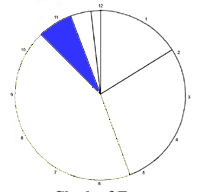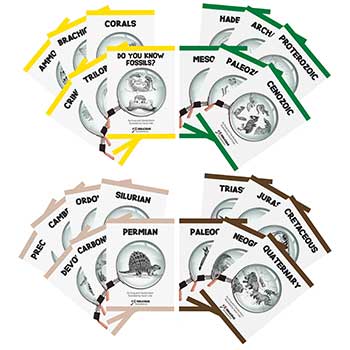Sign up for Lesson Plans, discounts & more!
Earth Science Lesson Plans
The Paleozoic Era
Notes for the leader/teacher on the Earth science lesson plans The Paleozoic Era: With the Paleozoic Era, the life forms explode into complexity. It is important to continue to use simple stories with not too much detail. As you continue with this lesson, give impressions rather than detailed descriptions of the various life forms. There are so many interesting life forms that this alone will encourage students to continue their own research of the amazing creatures that came into existence. Dialogue for the lesson is included in bold and italics. Things you would do during the lesson are in CAPITAL LETTERS.

Prerequisites for presenting The Earth science lesson plans The Paleozoic Era: Intro to Clock of Eras; Hadean, Archaean, and Proterozoic presentations
Materials for The Earth science lesson plans The Paleozoic Era:
- A clock of eras chart. Click here for a printable version
- A blank or non-colored chart Click here for a printable version
- Loose pieces for each of the Eras (You’ll use four sections in this lesson: The Hadean, Archaean, the Proterozoic and the Paleozoic.)
- (Optional: A large, black poster board or construction paper to use as a background.)
- Templates for student follow-up
Presentation of The Earth science lesson plans The Paleozoic Era:
- Review previous lesson(s)
(SHOW BLANK CLOCK OF ERAS AND LAY DOWN EACH PERIOD AS YOU REVIEW THE NAMES.)
We’ve been learning about the Earth’s creation using our Clock of Eras. So far we’ve learned about the Hadean Time, the Archaean Time and the Proterozoic Era. (PICK UP THE PROTEROZOIC AS YOU REVIEW ITS CHARACTERISTICS.)
The last Era was the Proterozoic. This was the time that the new cells were working with the sun to form an oxygen-rich atmosphere. It was the time the foraminiferans were removing the deadly mineral salts from the oceans. All of this activity was making just the right conditions for life. - (PLACE THE BLUE PALEOZOIC ERA ON THE BLANK CLOCK.)
The Paleozoic Era is colored blue on the Clock of Eras to remind us that all the new life, the oldest life forms on the planet, was in the water. After the foriminiferans took care of the salt problem, the seas were prepared for life forms. And well-prepared it was. There was literally an explosion of life forms at the beginning of the Paleozoic Era. The Cambrian Explosion marks the era with thousands of species of life forms in the ancient seas. It is this characteristic: life in the ancient sea, which makes the Paleozoic Era different from all the ones that came before it. You see, the cyanobacteria’s makeup didn’t just add oxygen to the atmosphere. It was an entirely new sort of structure: one that had a special container and a special “remembering” part called the nucleus. These new cells could join together to make different kinds of animals and plants. The tissues that made up these organisms were made to survive in a particular environment. Some would live on the bottom sediments, burrowing with tube-shaped bodies or walking with many tiny legs. - Others would live in the ocean column,
developing fins for effective swimming.
The Paleozoic Era is divided into six periods.
Each period is very different from the one before or after it. The first
of these was the Cambrian Period.
The Cambrian Period had so many new life forms that it is often
called the Cambrian Explosion. There were arthropods, mollusks, and
echinoderms. The most famous animal of the Cambrian was the trilobite.
It had more than 100 different species during the Cambrian Period.
The plants of the Cambrian were simple one-celled algae. Sometimes algae cells lived together in a colony.
As the Paleozoic Era continued through the other periods, new species developed.
- Many new types of animal life appeared as the Paleozoic continued. One type, the cephalopod, was a mollusk that lived in the large opening at the end of their shell. As they grew, they would make a new, larger ring of shell at the open end. When they were ready to move out of their old ring, they made a thin wall behind them. These cephalopods had feet that grew out of their heads! Fish developed during the middle part of the Paleozoic Era. By the end of the Paleozoic, some organisms could live out of the water and were responsible for breaking down rocks and making soil. These were the lichens, a partnership between fungi and algae. The Paleozoic Era came to an end with a mass extinction. Something caused conditions on Earth to change dramatically. As much as 95% of the life on Earth died out at this time.
Follow-up for The Earth science lesson plans The Paleozoic Era:
- Color or cut & paste the parts of the clock through the Paleozoic Era including labels.
- Research particular periods of the Paleozoic. Make illustrations or dioramas to represent the periods.
- Fossil Dig Activities
- Research individual animals. Make models of the animal in its habitat.
- Research the parts of a cell with emphasis on the cell wall and nucleus.
Finished with The Earth science lesson plans The Paleozoic Era? The next lesson is The Mesozoic.
The lesson before The Earth science lesson plans The Paleozoic is the Proterozoic
More on The Clock of Eras
Check out some of the Educational Materials for sale on our sister site fossilicious.com.

interested in more? If so, you may want to check out our other sites:
fossilicious.com - Our online fossil and mineral rock shop.
rocksandminerals4u.com - An educational site about rocks, minerals, and geology.
Geologic Time Geologic Time Line
Cenozoic Era
Quaternary
Neogene
Paleogene
Mesozoic Era
Cretaceous
Jurassic
Triassic
Paleozoic Era
Permian
Carboniferous
Devonian
Silurian
Ordovician
Cambrian
Archean Time
Hadean Time
Teachers Resources
Activities for Education and Fun
Earth Science Lesson Plans
Activities For Kids
Fossil Lesson Plans
Fossil Activities
Education Articles
Coloring Pages
Dinosaur Coloring Pages
Montessori Materials
Geology Club
Fossil Hunting
 |
 |
 |




